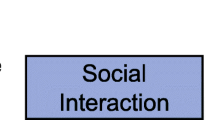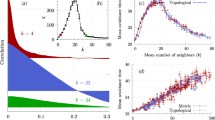Abstract
We study the impact of network size in the context of interactions within social network services (SNS) on cooperation among its users, as well as that of the speed of information update about other neighbors during interaction, using an enhanced version of a swarm model that uses prisoner’s dilemma as social interaction strategy and that models users’ interactions through kinematics. We focus on the speed of information update about social environments and study the relationships between the resulting patterns of cooperation in different information update rates. We observed the large variations among emerging many cooperative clusters in size, speed, and cooperation rate in the large population. Moreover, cooperation was more promoted when the information update rate was high, in contrast to low update rate where the population converged to a few large clusters with many wandering defectors.







Similar content being viewed by others
References
Hofbauer J, Sigmund K (1998) Evolutionary games and population dynamics. Cambridge University Press, Cambridge
Hawkins RXD, Goldstone RL (2016) The formation of social conventions in real-time environments. PLoS ONE 11(3):e0151670
Friedman D, Oprea R (2012) A continuous dilemma. Am Econ Rev 102:337–363. https://doi.org/10.1257/aer.102.1.337
Nowak MA, May RM (1992) Evolutionary games and spatial chaos. Nature 246:15–18
Nowak MA (2006) Five rules for the evolution of cooperation. Science 314:1560–1563. https://doi.org/10.1126/science.1133755
Pinheiro FL, Pacheco JM, Santos FC (2012) From local to global dilemmas in social networks. PLoS ONE 7:e32114. https://doi.org/10.1371/journal.pone.0032114
Rand DG, Nowak MA, Fowler JH, Christakis NA (2014) Static network structure can stabilize human cooperation. Proc Natl Acad Sci USA 111:17093–17098. https://doi.org/10.1073/pnas.1400406111
Grujić J, Gracia-Lázaro C, Milinski M, Semmann D, Traulsen A, Cuesta JA (2014) A comparative analysis of spatial prisoner’s dilemma experiment, conditional cooperation and payoff irrelevance. Sci Rep 4:4615. https://doi.org/10.1038/srep04615
Meloni S, Buscarino A, Fortuna L, Frasca M, Gómez-Gardeñes J, Latora V (2009) Effects of mobility in a population of prisoner’s dilemma players. Phys Rev E 79:067101. https://doi.org/10.1103/PhysRevE.79.067101
Vainstein MH, Silva ATC, Arenzon JJ (2007) Does mobility decrease cooperation? J Theor Biol 244:722–728
Sicardi EA, Fort H, Vainstein MH, Arenzon JJ (2009) Random mobility and spatial structure often enhance cooperation. J Theor Biol 256:240–246
Aktipis CA (2004) Know when to walk away: contingent movement and the evolution of cooperation. J Theor Biol 231(2):249–260
Luo-Luo J, Wen-Xu W, Ying-Cheng L, Bing-Hong W (2010) Role of adaptive migration in promoting cooperation in spatial games. Phys Rev E 81:036108
Antonioni A, Tomassini M, Sánchez A (2015) Short-range mobility and the evolution of cooperation: an experimental study. Sci Rep 5:10282. https://doi.org/10.1038/srep10282
Efferson C, Roca CP, Vogt S, Helbing D (2016) Sustained cooperation by running away from bad behavior. Evol Human Behav 37:1–9
Dunbar R (1992) Neocortex size as a constraint on group size in primates. J Hum Evol 22:469–493. https://doi.org/10.1016/0047-2484(92)90081-J
Nishimoto K, Suzuki R, Arita T (2013) Social particle swarm: explosive particle dynamics on cooperative/defective forces. In: Proceedings of 2013 IEEE symposium on artificial life (IEEE ALIFE2013), Singapore, 16–19 April 2013, pp 134–139
Suzuki R, Ito M, Kodera S, Nishimoto K, Arita T (2018) An online experimental framework for cooperative relation-ships with a real-time decision- making and rewarding environment. Front Ecol Evol 6:74. https://doi.org/10.3389/fevo.2018.00074
Kodera S, Suzuki R, Nishimoto K, Arita T (2017) A multiplayer online game-based experimental framework for observing continuous dynamics of human social relationships. In: Proceedings of the international symposium on artificial life and robotics (AROB 2017), Oita, 19–21 April 2017, pp 147–152
Ren J, Wu X, Wang W-X, Cheng G, Wang B-H (2006) Interplay between evolutionary game and network structure. arXiv:physics/0605250
Richmond P, Chimeh MK (2017) FLAME GPU: complex system simulation framework. In: Proceedings of 2017 international conference on high performance computing & simulation (HPCS), Genoa, 17–21 July 2017, pp 11–17
Reynolds C (1999) Steering behaviors for autonomous characters. In: Proceedings of Game Developers Conference, pp 763–782
Martin E, Hans-Peter K, Jörg S, Xiaowei X (1996) A density-based algorithm for discovering clusters in large spatial databases with noise. In: Proceedings of the second international conference on knowledge discovery and data mining (KDD’96), Portland, 2–4 August 1996, pp 226–231
Acknowledgements
This work was supported in part by JSPS/MEXT KAKENHI, JP17H06383 in #4903, JP17KT0001 and Topic-Setting Program to Advance Cutting-Edge Humanities and Social Sciences Research JP17J0011b.
Author information
Authors and Affiliations
Corresponding author
Additional information
Publisher's Note
Springer Nature remains neutral with regard to jurisdictional claims in published maps and institutional affiliations.
About this article
Cite this article
Elhamer, Z., Suzuki, R. & Arita, T. The effects of population size and information update rates on the emergent patterns of cooperative clusters in a large-scale social particle swarm model. Artif Life Robotics 25, 149–158 (2020). https://doi.org/10.1007/s10015-019-00558-6
Received:
Accepted:
Published:
Issue Date:
DOI: https://doi.org/10.1007/s10015-019-00558-6




